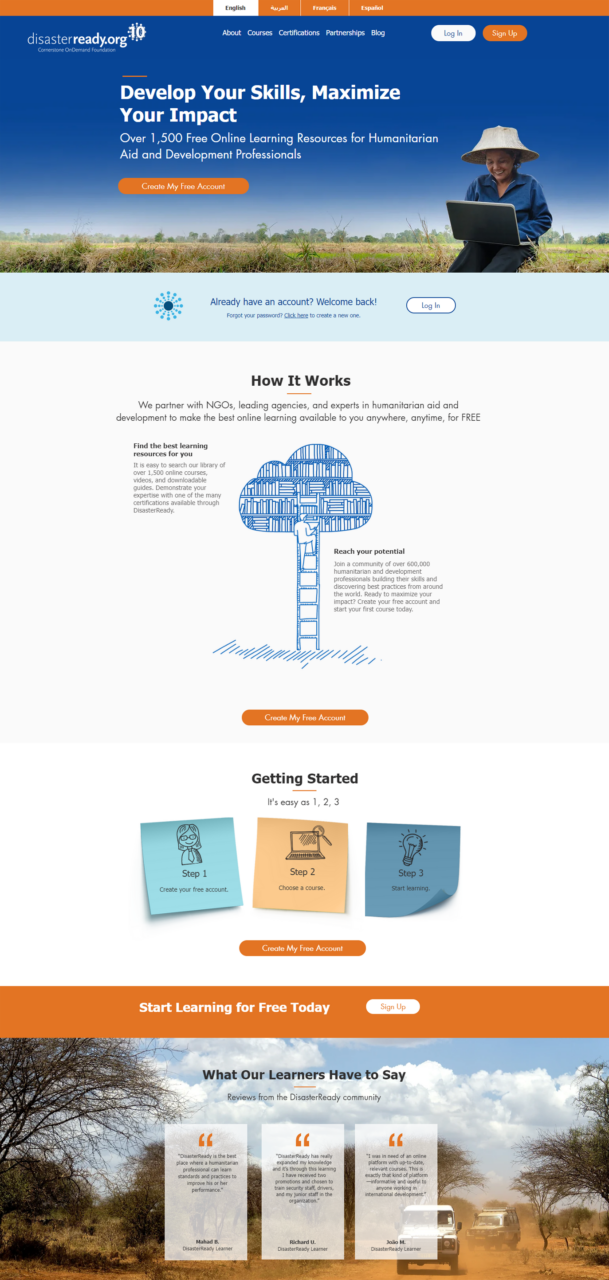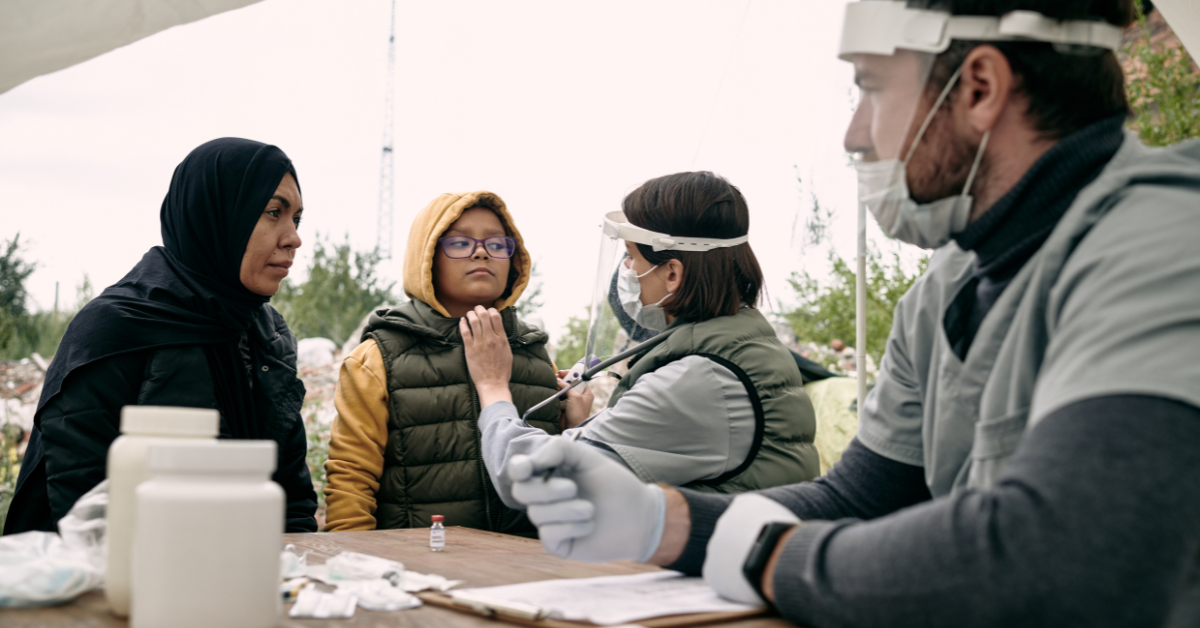Technology continues to change the way we access information, but one of its most impactful applications is its effect on learning and development.
In the humanitarian and development sector, professionals must not only be proficient in important interpersonal and technical skills, but they must also be proactive in situations that require them to learn new skills or refine existing ones. Among these skills are critical thinking, communication, teamwork, cultural sensitivity and networking, and dozens more.
According to the United Nations Office for the Coordination of Humanitarian Aid’s Global Humanitarian Overview 2023 report, the number of individuals in need of humanitarian aid is rising: In 2023, a record 339 million people reportedly needed some sort of humanitarian assistance and protection, which is a significant increase from 274 million people at the beginning of 2022.
With this in mind, it’s more important than ever for humanitarian and development professionals to have accessible resources and learning opportunities they can use anytime and anywhere.
When heavy monsoon rains led to disastrous flooding in Pakistan in 2010, destroying homes, livelihoods and community infrastructure, ultimately impacting 20 million people, Save the Children responded with aid. But before deploying thousands of humanitarian workers to Pakistan’s impacted areas, they needed training. Save the Children’s leadership team quickly realized they were faced with a huge training dilemma.
At the time, the organization was already using Cornerstone OnDemand’s learning management system to access some of its training courses through the organization’s nonprofit arm. So, they reached out and asked for help, says Tina Bolding, director of DisasterReady.
“Within just a few days, we created an online learning portal,” she says. “And that enabled [Save the Children] to get all their people trained and deployed as quickly as possible.”
Critical response
Realizing there was a demand in the sector for this type of access to learning, training and other resources for humanitarian and development professionals, Cornerstone and leaders from various aid organizations formed an advisory committee to construct a pilot program that would provide online learning to 20 humanitarian and development organizations serving in 11 countries.
“There were a lot of humanitarian aid organizations in the same situation,” Bolding says. “And there were individuals in humanitarian and international development roles who needed the same kind of high-quality online learning in order to prepare themselves to do their job effectively and safely.”

With most training at the time being face-to-face, this concept would revolutionize the way training is accessed by humanitarian and development professionals all over the world.
“You might be an aid organization that has an office in Addis Ababa in Ethiopia, and the majority of your staff might be right there at the headquarters,” Bolding says. “But, you also have pockets of staff that are 10 hours out. It’s difficult to get everybody in a van and drive 10 hours to the office for training.”
This pilot program would eventually become DisasterReady, the largest free online learning platform for humanitarian and development professionals.
“One of the best models of corporate social responsibility is when a company takes its core business—what it does best—and finds a way to meet an urgent need that the world has,” says Jacob Little, head of global social impact at Cornerstone. “When those two come together, you get a unique value proposition for how a company can contribute to the betterment of society.”
Powered by Cornerstone’s learning management system, DisasterReady—now celebrating its 10th anniversary—has a catalog of more than 1,500 on-demand and self-paced courses that is accessed by approximately 1.3 million workers deployed in 195 countries.
Collaboration for the greater good
Last year, DisasterReady began a partnership with CADUS, a German-based humanitarian aid organization that responds to crises, conflict and disasters with medical and technical aid. The name “CADUS” comes from the Latin term for thistle, “carduus,” and alludes to the protection that flowers get from their surrounding thistles.
For the past four years, CADUS has been working to obtain its Emergency Medical Team classification through the World Health Organization. CADUS had one training course created in-house by their education program manager that was for their emergency medical response team, says Mike Liontiris, medical director at CADUS. It was a start, but they were looking for more.
“Because we’re a very small organization, we didn’t have the resources to create a whole curriculum or reinvent the wheel for things that already exist,” Liontiris says.
So, they reached out directly to DisasterReady and together, they worked to set up a new learning portal for CADUS staff and volunteer aid workers. Through the portal, learners can set up an account and select from several learning pathways: Head of mission, non-clinical, clinical and core humanitarian.
Each of these learning pathways contains a number of training courses on topics such as bystander intervention, personal safety and security and mental health. These courses all range in size. One basic humanitarian fundamentals course takes no more than a few minutes to complete, but there is also a clinical management course that takes about five hours to complete.
“If it weren’t for that course, for example, we would have needed to create it for ourselves, and that would’ve taken out of our capacity to do something else,” Liontiris says.
DisasterReady’s partnership with CADUS is just one example of how they make themselves an accessible resource for humanitarian and development professionals. They continuously collaborate with organizations of all kinds and sizes in the sector to deliver relevant training and resources to individuals responding on the ground with humanitarian aid.
For example, Boldings says they work with many of their partners on original content to meet the demand in critical skill areas, such as flood safety or shelter and settlements. Having accessible learning and training allows their partners to allot more time and resources elsewhere. Specifically for CADUS, their partnership with DisasterReady has given the organization more time to focus on its core mission of providing emergency medical and technical response.

Recently, CADUS has grown, Liontiris says. “[We have] grown from a very small NGO responding to one crisis at a time with a small team, to, currently, having a two-year project in Ukraine, very close to the frontline,” he says. “And also being one of the first NGOs to enter Gaza.”
Liontiris says the mission in Gaza has probably been one of the most challenging for the organization in terms of safety, security and coordination logistics.
“But we want to go where other organizations do not because this is where we see actual need,” he says.
CADUS currently also has aid workers deployed in Bosnia working with refugees and in Papua Guinea as part of an EMT mission and COVID-19 response. They are also just a few months away from completing their WHO classification.
A demand for kindness
About 70 percent of Americans believe it’s important for companies to help make the world a better place.
And, according to the Center for Creative Leadership, organizations that invest in initiatives and leadership related to corporate social responsibility benefit in a number of ways. For example, CSR initiatives matter to a large majority of Millennial employees—who make up about 35 percent of the workforce.
“There’s a broad understanding that what happens in the world impacts the way employees show up to work,” Little says. “And there’s data to show that when employees feel like they belong and feel seen, they produce better work.”
Little says this means that when there’s a geopolitical conflict, natural disaster or something else that puts people at risk, employees want their companies to take a stand.
Additionally, according to CCL, practicing corporate social responsibility can also be good for business. Organizations that invest in corporate social responsibility initiatives and leadership can boost the bottom line; they are linked to increased purchasing behavior, higher customer satisfaction and higher market value.
“Customers want to do business with responsible companies,” Little says.
At Cornerstone, they realized they could harness their passion for education to make a positive impact on the world, Little says.
“We are a learning company, and our original tagline was ‘educating the world.’” Little adds. “We believe in the intrinsic value of education, learning and growth.”
Going forward, Bolding says DisasterReady is continuing its own mission of providing access to learning to its partners on the ground responding to disaster, crisis and conflict. Specifically, they are looking at learner feedback surveys to determine how to best serve their partners as the sector faces increasing challenges in climate change and sustainability.
Bolding says there are so many barriers to access to training and skills development in the humanitarian and development sector, but DisasterReady has allowed humanitarian aid organizations of all sizes to focus on training its staff in areas and skills relevant to their critical roles.
“Our mission is to help transform the way people help people,” Bolding says.















